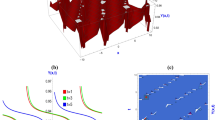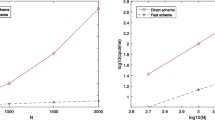Abstract
We show that an explicit method for solving hyperbolic partial differential equations can be applied to a model of a renal tubule to obtain both dynamic and steady-state solutions. Appropriate implementation of this method eliminates numerical instability arising from reversal of intratubular flow direction. To obtain second-order convergence in space and time, we employ the recently developed ENO (Essentially Non-Oscillatory) methodology. We present examples of computed flows and concentration profiles in representative model contexts. Finally, we indicate briefly how model tubules may be coupled to construct large-scale simulations of the renal counterflow system.
Similar content being viewed by others
Literature
Chandhoke, P. S. and G. M. Saidel. 1981. Mathematical model of mass transport throughout the kidney: effects of nephron heterogeneity and tubular-vascular organization.Ann. biomed. Engng 9, 263–301.
Crank, J. 1956.The Mathematics of Diffusion. London: Oxford University Press.
Cussler, E. L. 1984.Diffusion: Mass Transfer in Fluid Systems. New York, NY: Cambridge University Press.
Harten, A. and S. Osher. 1987. Uniformly high-order accurate nonoscillatory schemes.SIAM J. Numer. Anal. 24, 279–309.
Harten, A., B. Engquist, S. Osher and S. Chakravarthy. 1986. Some results on uniformly high-order accurate essentially nonoscillatory schemes.Appl. Numer. Math. 2, 347–377.
Harten, A., B. Engquist, S. Osher and S. Chakravarthy. 1987. Uniformly high order accurate essentially non-oscillatory schemes, III.J. comput. Phys. 71, 231–303.
Knepper, M. A., R. A. Danielson, G. M. Saidel and R. S. Post. 1977. Quantitative analysis of renal medullary anatomy in rats and rabbits.Kidney Int. 12, 313–323.
Layton, H. E. 1990. Urea transport in a distributed loop model of the urine-concentrating mechanism.Am. J. Physiol. 258, F1110-F1124.
Layton, H. E., E. B. Pitman and M. A. Knepper. In review. A dynamic numerical method for models of the urine concentrating mechanism.SIAM J. Appl. Math.
Lory, P. 1980. Numerical solution of a kidney model by multiple shooting.Math. Biosci. 50, 117–128.
Lory, P. 1987. Effectiveness of a salt transport cascade in the renal medulla: computer simulations.Am. J. Physiol. 252, F1095-F1102.
Meija, R. and J. L. Stephenson. 1979. Numerical solution of multinephron kidney equations.J. comput. Phys. 32, 235–246.
Meija, R. and J. L. Stephenson. 1984. Solution of a multinephron, multisolute model of the mammalian kidney by Newton and continuation methods.Math. Biosci. 68, 279–298.
Moore, L. C. 1979. Urea and NaCl transport in thin Henle's loops: dynamic response in water diuresis-antidiuresis transition, pp. 51–62. Dissertation, University of Southern California.
Moore, L. C. and D. J. Marsh. 1980. How descending limb of Henle's loop permeability affects hypertonic urine formation.Am. J. Physiol. 239, F57-F71.
Mulder, W., S. Osher and J. A. Sethian. 1992. Computing interface motion in compressible gas dynamics.J. comput. Phys. 100, 209–228.
Pitman, E. B., H. E. Layton and L. C. Moore. 1994. Numerical simulation of propagating concentration profiles in renal tubules.Bull. math. Biol. 56, 567–586.
Schultz, S. G. 1980.Basic Principles of Membrane Transport. New York, NY: Cambridge University Press.
Stephenson, J. L. 1972. Concentration of urine in a central core model of the renal counterflow system.Kidney Int. 2, 85–94.
Stephenson, J. L. 1992. Urinary concentration and dilution: models. In:Handbook of Physiology: Section 8:Renal Physiology. E. E. Windhager (Ed.), pp. 1349–1408. New York: Oxford University Press.
Stephenson, J. L., R. P. Tewarson and R. Mejia. 1974. Quantitative analysis of mass and energy balance in non-ideal models of the renal counterflow system.Proc. natn. Acad. Sci. U.S.A. 71, 1618–1622.
Stephenson, J. L., Y. Zhang, A. Eftekhari and R. Tewarson. 1987. Electrolyte transport in a central core model of the renal medulla.Am. J. Physiol. 253, F982-F997.
Stephenson, J. L., Y. Zhang and R. Tewarson. 1989. Electrolyte, urea, and water transport in a two-nephron central core model of the renal medulla.Am. J. Physiol. 257, F399-F413.
Strang, G. 1963. Accurate partial difference methods: I. Linear Cauchy problems.Arch. Rat. Mech. Anal. 12, 392–402.
Tewarson, R. P., J. L. Stephenson, M. Garcia and Y. Zhang. 1985. On the solution of equations for renal counterflow models.Comput. Biol. Med. 15, 287–295.
Wexler, A. S., R. E. Kalaba and D. J. Marsh. 1986. Automatic derivative evaluation in solving boundary value problems: the renal medulla.Am. J. Physiol. 251, F358-F378.
Wexler, A. S., R. E. Kalaba and D. J. Marsh. 1987. Passive, one-dimensional counter-current models do not simulate hypertonic urine formation.Am. J. Physiol. 253, F1020-F1030.
Wexler, A. S., R. E. Kalaba and D. J. Marsh. 1991a. Three-dimensional anatomy and renal concentrating mechanism. I. Modeling results.Am. J. Physiol. 260, F368-F383.
Wexler, A. S., R. E. Kalaba and D. J. Marsh. 1991b. Three-dimensional anatomy and renal concentrating mechanism. II. Sensitivity results.Am. J. Physiol. 260, F384-F394.
Wexler, A. S. and D. J. Marsh. 1991. Numerical methods for three-dimensional models of the urine concentrating mechanism.Appl. math. Comput. 26, 237–244.
Author information
Authors and Affiliations
Rights and permissions
About this article
Cite this article
Layton, H.E., Pitman, E.B. A dynamic numerical method for models of renal tubules. Bltn Mathcal Biology 56, 547–565 (1994). https://doi.org/10.1007/BF02460470
Received:
Issue Date:
DOI: https://doi.org/10.1007/BF02460470




